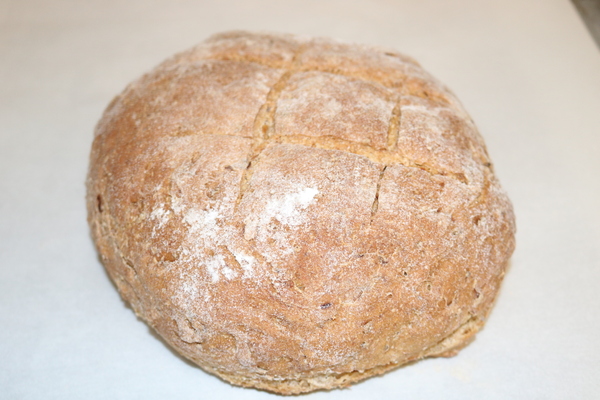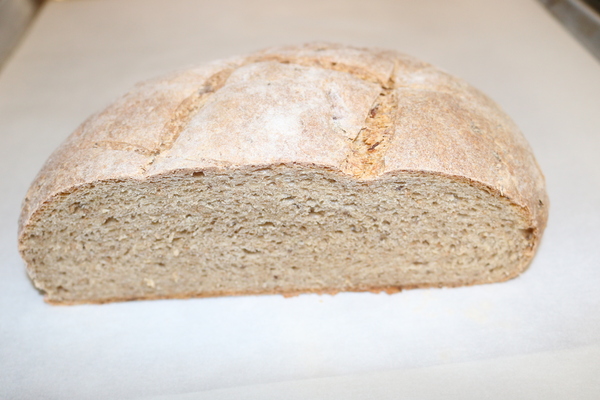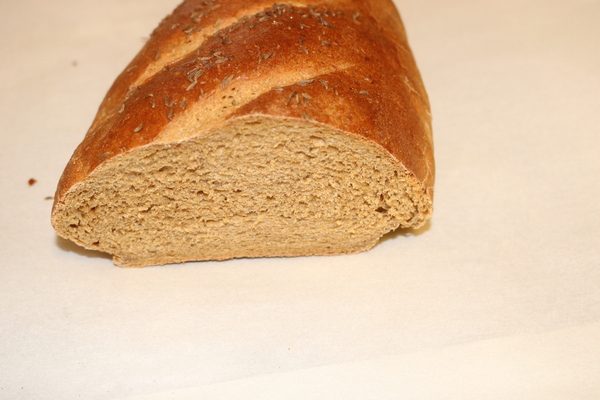Home › Forums › Baking — Breads and Rolls › Coming Through the Rye
- This topic has 138 replies, 11 voices, and was last updated 3 years, 6 months ago by
Mike Nolan.
-
AuthorPosts
-
January 21, 2020 at 5:00 pm #20552
I wonder which has more LAB, yogurt or buttermilk?
January 21, 2020 at 6:27 pm #20554Sounds like a quiz question to me, Mike! 🙂
I'm tempted to buy a carton of full-fat Stoneyfield yogurt and try the bread with it.
January 22, 2020 at 1:39 pm #20581Report on Sauerkraut Bread (The Rye Baker pps 212-214):
This recipe made two loaves about 7 inches in diameter and 3 inches high. The baked weight was 787 grams (27 3/4 ounces.)
I wound up adding a bit more flour than the recipe called for, I think I mis-measured the water, but the dough came together fairly well. However, the dough weight was still a little less than what the recipe suggested, so maybe I worked less flour into the dough during shaping.
It slices better after sitting overnight.
I didn't have Polish sauerkraut so I used what I had, the kraut isn't overly assertive but it does add to the aroma of the bread when toasting it and the flavor is reminiscent of sauerkraut that has been cooked with sausage.
I tried it in a Reuben sandwich, the flavor of the baked sauerkraut clashed a bit with the raw sauerkraut, and I think the biggest challenge with this bread might be figuring out what foods pair best with it.
It tastes good toasted with a little butter, but the sauerkraut flavor probably wouldn't pair well with things you normally spread on toast, like jams. I probably would not make this bread unless I had a specific meal I wanted to make that the sauerkraut taste would pair with.
For comments on the preparation of this recipe, see Sauerkraut Rye Comments
Followup: I tried a slice with some cheddar cheese spread on it today, it was very good. Either the sauerkraut has mellowed or it pairs quite well with the cheese spread.
-
This reply was modified 5 years, 10 months ago by
Mike Nolan.
-
This reply was modified 5 years, 10 months ago by
Mike Nolan.
-
This reply was modified 5 years, 10 months ago by
Mike Nolan.
-
This reply was modified 5 years, 10 months ago by
Mike Nolan.
Attachments:
You must be logged in to view attached files.January 22, 2020 at 7:55 pm #20599Report on Old Milwaukee Rye (The Rye Baker pps 98-101):
The recipe made two loaves. Although Ginsberg recommends a football shaped loaf, I made more of a cylindrical one, because that way the slices are more uniform in size. The loaves are about 11 inches long with a cross section of about 5 inches by 3 inches. The finished loaf weighs 696 grams or about 24 1/2 ounces.
This dough came together quickly and looked and felt quite a bit like gingerbread, not at all sticky. It rose well, though a little slow, that might have just been the kitchen temperature. It baked a little faster than the recipe called for, but that may have been due to how I shaped it.
The caraway seeds on the outside didn't stick very well, I may not have had enough egg in the egg wash. And I remembered why I generally don't put caraway seeds on the outside, they get very hard and stick in between my teeth.
The bread is fairly dark on the inside, due in large part to the molasses. There's a noticeable aftertaste from the molasses, but it is not an unpleasant one. I think that may fade a little over time, when the loaves came out of the oven the molasses odor was much stronger.
We think the bread is very tasty as a sandwich bread, it would probably make excellent Reubens, too. It reminds me a bit of the rye bread I get in the Amish store in Iowa.
It toasts very well and I think it would pair quite well with stronger toppings, like an apple butter. I think there's a good chance I'll make this bread again.
Followup: It tastes even better on day 2.
-
This reply was modified 5 years, 10 months ago by
Mike Nolan.
-
This reply was modified 5 years, 10 months ago by
Mike Nolan.
Attachments:
You must be logged in to view attached files.January 22, 2020 at 8:45 pm #20605Mike, that rye bread looks wonderful. It's been a while since I've made rye, but I might have to do one soon. When I've made it, I usually shape it like you did, but I have made it into a round and also panned it a couple of times. Of course, I've also made them into buns, my favorite form of bread.
January 22, 2020 at 9:07 pm #20606King Arthur used to sell a 'deli rye' pan, with sides that sloped out sort of like a trapezoid, but it looks like they no longer have it. I thought it was a Chicago Metallic pan, but they don't seem to have it on their site, either. Specialty pans come and go, I guess, I've got several that nobody seems to carry any more. (And I've got two large glass pans that I broke the lid to one of, but the French maker no longer makes that size.)
The main reason I bake most of my breads freeform is that I prefer a crust that has some body to it.
January 23, 2020 at 8:40 am #20609That bread looks great, Mike, and it's good to know that it tastes great as well.
I'm going to try toasting a piece of my Yogurt Rye Bread and see if that gives it more flavor.
I have two of the deli rye pans, and I use them for some breads, particularly my Limpa bread.
I plan to bake the Yogurt Rye again today. I bought full-fat Stonyfield yogurt yesterday on our shopping run to the next town. I was surprised that Walmart had it. At 7g saturated fat per cup (250g), I won't be snacking on it, but I will use the remainder to try making my own yogurt with 1% milk, so the remainder won't go to waste. I have a yogurt maker (the little jars).
I'm curious to see if the added fat makes a difference. Ginsberg did not specify a type of yogurt or what its fat content should be. The bread has no additional added fat. I'm also wondering if the buttermilk I'm buying does not have enough of the LAB to give the tang. The buttermilk that I cultured, using 200 ml of it to 600 ml 1% milk never thickened. I prefer Dean's, but I cannot get it in a half gallon. I also note that it now is 2% fat per cup rather than the 1.5% it was.
I'm also planning on using the Zo, since as I noted above, I had to keep stopping the mixer to pull the dough together, and that got aggravating over a 10-minute kneading session.
-
This reply was modified 5 years, 10 months ago by
BakerAunt.
January 23, 2020 at 8:42 am #20610Good luck on your rye bread! They all look tasty.
January 23, 2020 at 8:54 am #20613They all look beautiful! Does the Old Milwaukee rye have Old Milwaukee? Does it even still exist?
I am envious of you folks.
I have a question about starters. If I make one a nd have it going and tend it on Mondday morning then leave it until Thursday night, will it be okay? What happens to your starters when you go on a trip? Mike, you go visit family in Pittsburgh so what happens to your starter then?
Thanks
January 23, 2020 at 9:41 am #20615Mike all your breads look wonderful!
Aaron my starter is stored in the refrigerator and can be neglected for long amounts of time and then pulled out and it comes right back after a few feedings.
January 23, 2020 at 11:25 am #20620I have one of those thick liquid sourdough starters. Like Joan's starter, I can ignore it for weeks--or over a month. It may need an extra feeding or two to get it back up to power, but that is one reason I started doing the sourdough crackers, and it's good in pancakes. This starter is a milk-based one.
I have the same question you have about rye starters, which is why I've resisted starting one.
-
This reply was modified 5 years, 10 months ago by
BakerAunt.
January 23, 2020 at 11:28 am #20622Once you've got a starter well-established, it can be pretty tolerant. I know people who've forgotten they had a starter and found it at the back of a refrigerator shelf weeks or months later and it bounced back just fine.
I'm in the last few days of building my rye starter, so it hasn't gone in the fridge yet. It's pretty active at this point, I refreshed it around 10 PM last night and by 10 AM this morning it had doubled. It has an interesting but fairly pleasant sour aroma.
I think if you've got a week or so when you'll be at home, you can probably build a rye starter using Ginsberg's protocol, then stick it in the fridge. A day or two before you're ready to bake, take a small amount of the starter, mix it with some rye flour and warm water, and let it sit on the counter for a day, it should be ready to go.
I've saved up all the discards, they're in the fridge. I'm planning to use them for some of the Ginsberg recipes. (Right now I'm thinking of trying the Munich Penny rolls next, I've ordered some rye malt and will toast it to produce red rye malt--lightly toasted).
There's no beer in the Old Milwaukee bread, though I think there are a few of Ginsberg's recipes that do use beer in them. I'm not a beer drinker, but I think that Old Milwaukee beer is still on the market.
Making 78 rye recipes is likely to produce rye bread fatigue here, so I'm thinking I may do 2 or 3 then take a break of a week or two. I may have to try a few new non-rye recipes just for a change of pace, too. Maybe I'll try Hamelman's wild yeast raisin bread recipe again, last time I got the wrong kind of mold on the top of the raisin water and had to throw it out. Debbie Wink says that sometimes happens, raisins can have several types of mold spores on them, including Botrytis cinerea, the grey mold responsible for 'noble rot' in Sauternes dessert wines.
January 24, 2020 at 11:00 am #20648Thanks for all the tips on starters. Looks like I'll need a week at home and then I will be good to go after that.
January 24, 2020 at 12:51 pm #20649On Thursday, I again Baked the Yogurt Rye Bread from Ginsberg’s book, but this time I used full-fat Stonyfield yogurt that I bought on our grocery run yesterday. I also mixed and kneaded it in the Zo bread machine, which worked much better than my mixer for this smaller amount of dough. The dough baked into the same size of loaf, still about 3 ¾ inches high. I’ll slice it tomorrow, as we have already eaten the first loaf I baked.
Note from the next day: The bread has much better flavor and texture with the full-fat yogurt. It is still a firm bread, but the crumb seems softer to me. That may be the yogurt, but I also think that my bread machine contributed to the better texture. The bread is mild, but it does have flavor.
January 24, 2020 at 3:07 pm #20650It took me about 2 minutes last night to measure out 70 grams from the previous day's rye starter, add 70 grams of rye flour and 70 grams of water and stir it up. So a long weekend and a few minutes of coaching might be all it takes to get a rye starter launched.
One of the reasons I went away from using my Zo was that it didn't allow me to make adjustments on the fly to the process. A small change in the number of minutes of kneading or rising time might have affected the volume and crumb a lot. As Peter Reinhart once wrote, your dough will tell you what it needs.
-
This reply was modified 5 years, 10 months ago by
-
AuthorPosts
- You must be logged in to reply to this topic.



